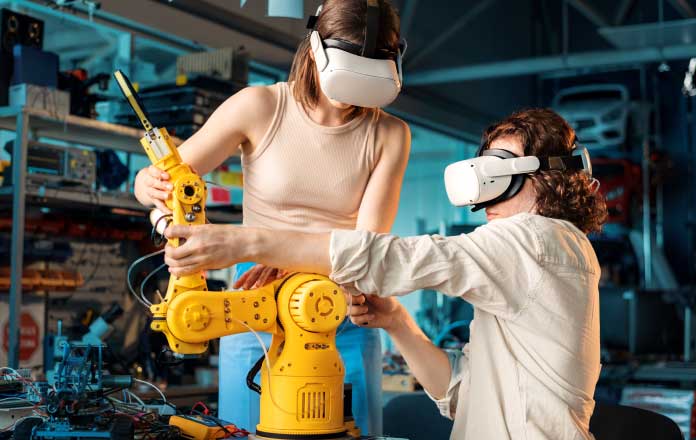Introduction
The manufacturing world is undergoing a transformative journey thanks to the integration of cutting-edge technologies. Virtual Reality (VR) has emerged as a game-changer among these innovations. In this article, we will delve into the various applications of VR in manufacturing and discuss its role in shaping the future of Industry 4.0.
Virtual Reality Applications for Manufacturing
Virtual Reality has swiftly found its place on the factory floor, enhancing numerous aspects of manufacturing. With VR, it’s possible to create immersive simulations that allow employees to visualize complex assembly processes, practice tasks, and troubleshoot issues, all in a risk-free digital environment. It reduces the learning curve and significantly improves efficiency and productivity.
Digital Twin for VR
Digital twins have become an integral part of VR in manufacturing. These digital replicas of physical assets and systems provide real-time insights, allowing manufacturers to monitor and optimize processes. Coupled with VR, digital twins enable engineers to step inside these digital models, providing a deeper understanding of how systems operate, leading to better-informed decision-making.
Point Cloud Applications in VR
Point cloud technology has revolutionized the way manufacturers capture real-world data. With VR, point clouds can create highly detailed and accurate virtual environments. It is beneficial for quality control, reverse engineering, and design analysis, as it allows for meticulously examining products and components.
Haptic Sensors in Virtual Reality
Haptic feedback is crucial in making VR experiences more realistic and helpful in manufacturing. Haptic sensors provide tactile feedback to users, allowing them to “feel” and interact with objects in the virtual world. In manufacturing, this is invaluable for tasks that require a sense of touch and precision, such as assembling intricate components or handling fragile materials.
Applications of Virtual Reality
The applications of VR in manufacturing are numerous. It is used for training, design, prototyping, maintenance, and remote collaboration. VR enables experts to collaborate globally on a single project, making it a valuable tool for multinational manufacturing operations.
VR for Manufacturing 4.0
Industry 4.0, also known as the fourth industrial revolution, emphasizes the integration of digital technologies into manufacturing processes. VR plays a pivotal role in this evolution. By bridging the physical and digital realms, VR is helping manufacturers harness data, automation, and connectivity to optimize production, reduce downtime, and enhance overall operational efficiency.
The Future of VR in Factory 4.0
The future of VR in manufacturing looks extremely promising. We can expect even more sophisticated VR applications as technology advances, further blurring the lines between the physical and digital worlds. With the advent of 5G, edge computing, and the Internet of Things (IoT), VR will become an even more integral part of smart factories, facilitating real-time data analysis and decision-making.
Conclusion
The promise of VR lies in its ability to improve efficiency, reduce errors, and foster innovation. As we move towards the future, manufacturers embracing VR technology will find themselves at the forefront of Industry 4.0, reaping the benefits of a more innovative, connected, and productive manufacturing environment. The transformation has already begun, and the integration of VR is set to play a pivotal role in shaping the future of manufacturing.
Read Also: How AR and VR Games Revolutionize the Gaming Experience?
Read Also: Unlocking Learning with Virtual Reality: A Path to Academic Success
Read Also: Exploring the Transformative Power of Virtual Reality in the Workplace



